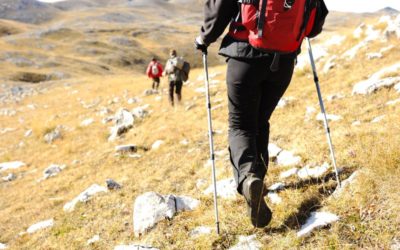Hiking is a great way to get outside, explore nature, and challenge yourself physically. Whether you’re new to hiking or an experienced pro looking for your next adventure, there are plenty of trails out there waiting for you. In this blog post, we’ll cover everything you need to know to plan your first hiking trip and find the perfect trail for you.
Introduction to Hiking: What You Need to Know
Before you hit the trail, there are a few things you should know about hiking. Here are some basics:
Choose the right shoes: A good pair of hiking boots can make all the difference on the trail. Look for sturdy, supportive shoes with good grip and ankle protection.

Dress appropriately: Depending on where you’re hiking, you may need to dress in layers. Bring a rain jacket just in case, and don’t forget sunscreen if you’re hiking in hot weather.
Pack enough water: Dehydration is a real risk when you’re exerting yourself on the trail. Make sure you bring enough water (and a way to purify it if necessary).
Plan ahead: Research the trail before you go, including its difficulty level, length, and any potential hazards. Check the weather forecast and let someone know where you’re going and when you expect to be back.

Choosing the Right Trail for Your Skill Level
Not all hikes are created equal, so choose one that matches your skill level. Here are some tips for finding the perfect trail:
Consider your fitness level: If you’re new to hiking, start with easy trails and work your way up. Don’t try to tackle a difficult hike right away.
Think about distance and elevation gain: Longer hikes will require more time and endurance, while steep inclines will test your strength and cardiovascular fitness.
Read reviews and check ratings: Online resources like AllTrails can help you find trails rated by other hikers, which can give you an idea of what to expect.
Essential Gear and Supplies for a Successful Hike
Once you’ve chosen your trail, it’s time to pack your gear. Here are some essentials you won’t want to leave home without:
Water bottles or hydration system
Snacks and energy bars
Navigation tools (map, compass, GPS)
Headlamp or flashlight
Whistle
First aid kit
Staying Safe on the Trail: Tips for Avoiding Injury or Emergencies
Safety should always be a top priority when you’re on the trail. Follow these guidelines to stay safe:
Stick to designated trails and avoid off-trail exploration.
Watch your footing and take breaks as needed to rest and regroup.
Be aware of wildlife and how to handle encounters safely.
Carry a phone and know how to use it to call for help if necessary.
Planning Your First Hiking Trip: From Research to Execution
Now that you have all the information you need, it’s time to plan your first hiking trip! Here are some steps to follow:
1. Choose a trail that fits your skill level and interests.
2. Research the trail and nearby amenities (campgrounds, lodging, restaurants).
3. Check the weather forecast and adjust your plans accordingly.
4. Prepare your gear and supplies.
5. Share your itinerary with friends or family members who can keep track of your progress.
6. Enjoy your hike and take lots of photos along the way!
Conclusion
Whether you’re a beginner or an experienced hiker, there’s nothing quite like hitting the trail and immersing yourself in nature. By following these tips and planning carefully, you can ensure that your first hiking trip is both enjoyable and safe. So lace up those boots, grab your gear, and get ready to discover the beauty of the great outdoors!



